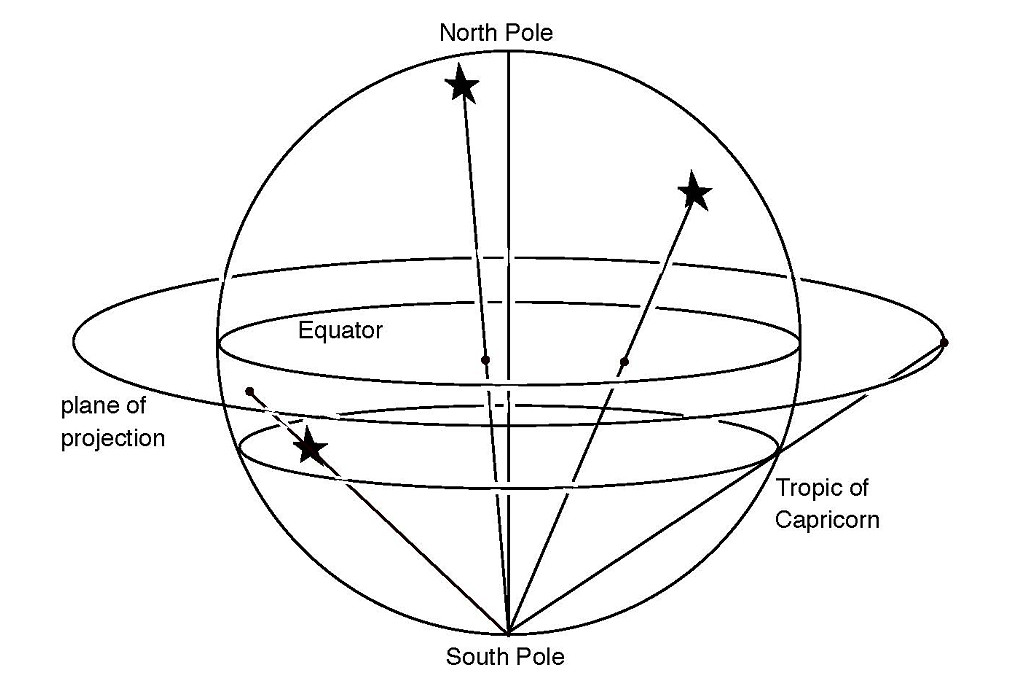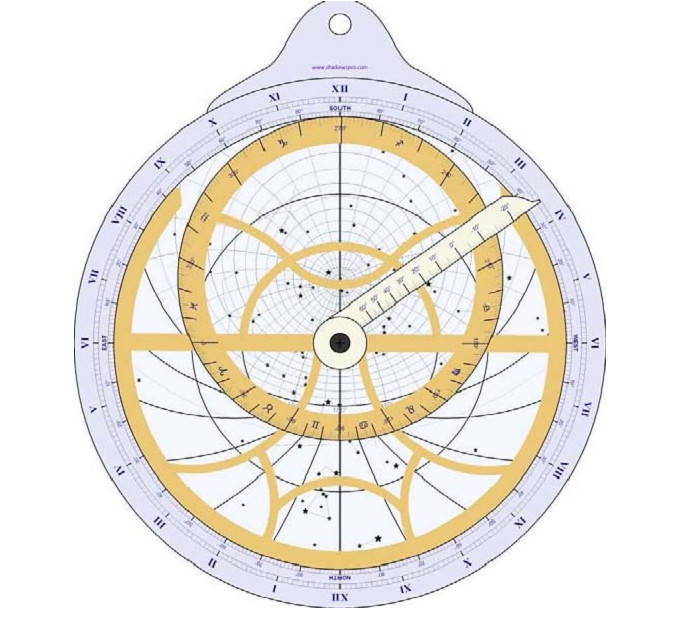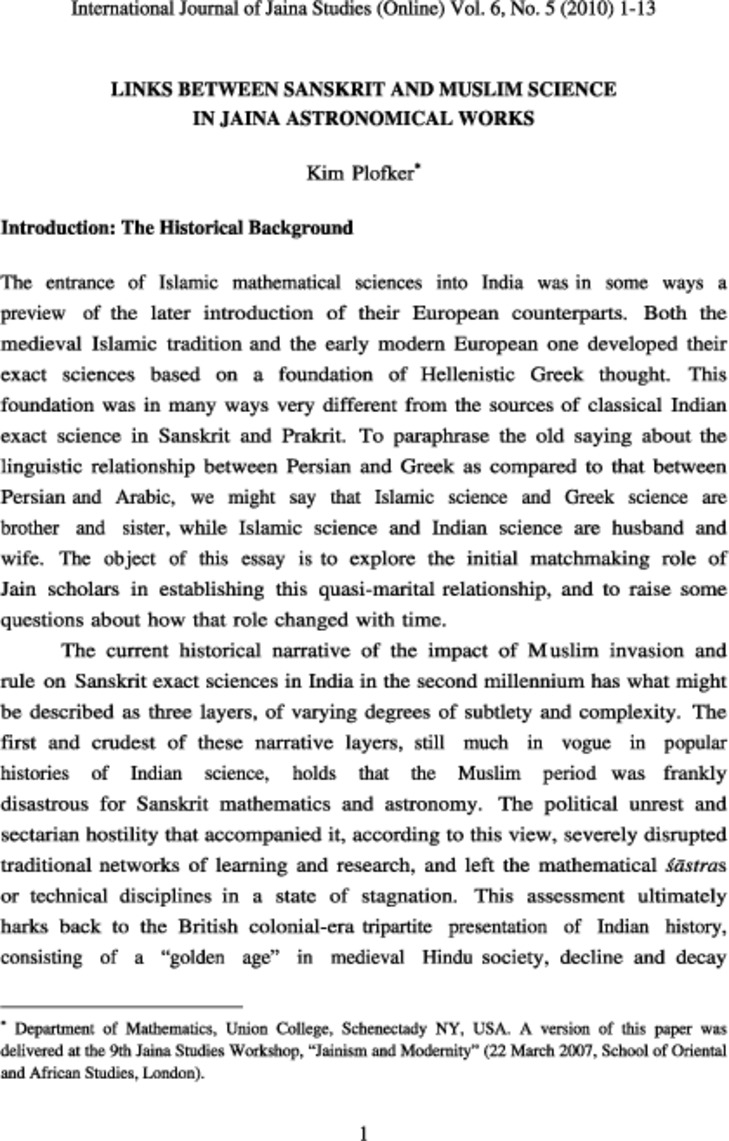
International Journal of Jaina Studies
(Online) Vol. 6, No. 5 (2010) 1-13
Kim Plofker
Department of Mathematics, Union College, Schenectady NY, USA. A version of this paper was delivered at the 9th Jaina Studies Workshop, “Jainism and Modernity” (22 March 2007, School of Oriental and African Studies, London).
Abstract
In the cross-fertilization between Islamic and traditional Indian exact sciences that took place in the courts of Hindu and Muslim rulers in second-millennium India, Jaina intermediaries played a significant part. Some important scientific ideas, such as the principles of the Islamic astrolabe and conversion calculations for the Islamic calendar, were first explained to Indian audiences in the works of Jaina authors. Muslim audiences, in their turn, received Indian astrological ideas attributed to an authority known only as "Jina". What factors placed the small minority of Jaina scholars at the center of these early efforts at scientific transmission? And what role did they play in the more familiar, and often more dramatic, encounters between Hindu and Muslim scientific views in subsequent centuries? The article argues that compared to its Hindu-majority counterpart, the Jaina scientific tradition was in some ways more receptive to, and simultaneously more insulated from, the new and foreign ideas of early modern Indo-Islamic science.Links Between Sanskrit and Muslim Science in Jaina Astronomical Works
Introduction: The Historical Background
The entrance of Islamic mathematical sciences into India was in some ways a preview of the later introduction of their European counterparts. Both the medieval Islamic tradition and the early modern European one developed their exact sciences based on a foundation of Hellenistic Greek thought. This foundation was in many ways very different from the sources of classical Indian exact science in Sanskrit and Prakrit. To paraphrase the old saying about the linguistic relationship between Persian and Greek as compared to that between Persian and Arabic, we might say that Islamic science and Greek science are brother and sister, while Islamic science and Indian science are husband and wife. The object of this essay is to explore the initial matchmaking role of Jain scholars in establishing this quasi-marital relationship, and to raise some questions about how that role changed with time.
The current historical narrative of the impact of Muslim invasion and rule on Sanskrit exact sciences in India in the second millennium has what might be described as three layers, of varying degrees of subtlety and complexity. The first and crudest of these narrative layers, still much in vogue in popular histories of Indian science, holds that the Muslim period was frankly disastrous for Sanskrit mathematics and astronomy. The political unrest and sectarian hostility that accompanied it, according to this view, severely disrupted traditional networks of learning and research, and left the mathematical śāstras or technical disciplines in a state of stagnation. This assessment ultimately harks back to the British colonial-era tripartite presentation of Indian history, consisting of a "golden age" in medieval Hindu society, decline and decay under the Muslims, and renewal under British rule.
The second narrative layer draws on a substantial body of evidence that directly contradicts many of the simplistic conclusions of the first. It points out that despite the turmoil generated by wars and political power struggles, scientific activity involving both Muslims and non-Muslims flourished at many royal courts, and many new Sanskrit technical treatises were produced in the Indo-Muslim period. While some of these treatises adhered to the traditional style and content of pre-Muslim Sanskrit works, others incorporated methods and models borrowed from Islamic science. The late David Pingree described numerous instances of these attempts at Indian and Islamic scientific synthesis in the works of authors like Nityānanda at the court of Shāh Jahān, the rival astronomical clans of Munīśvara and Kamalākara in seventeenth-century Benares, and the court astronomers of Jayasiṃha II in early eighteenth-century Jaipur.[1]
The third layer of interpretation, which has been explored most fully so far by Christopher Minkowski, adds further complications to the narrative. It seeks to explain the emergence of a sort of neo-traditionalism in Sanskrit astronomy in the second half of the second millennium. The authors of these works defended (and to a large extent invented) an ancient tradition of divinely inspired astronomy consistent with Hindu sacred cosmology, which allegedly had been misunderstood and distorted by later human scientists. It has been suggested that perhaps this neo-traditionalist perspective was partly inspired by reaction against assimilation of Islamic cosmological models as a manifestation of foreign, extra-dharmic, ideas.[2]
Thus the reaction of Sanskritic exact science to Islamic influence, depending on how closely one looks at it, can be characterized as paralysis, stimulated growth, conscious rejection, or some combination of the three. This layered narrative, which at present deals almost exclusively with interactions between Hindus and Muslims, becomes even more complex when we investigate the role of Jain scholars in these exchanges.
Hindu, Islamic and Jaina Astronomical Systems
Broadly speaking, there are two main cosmological models in pre-modern Hindu thought. The first, described in cosmogonic sacred texts, represents the earth as a flat disk centered on the divine mountain Meru, the axis mundi. The other model forms part of classical Indian spherical astronomy, which was initially influenced by Hellenistic theories and methods, and in many respects resembles standard Graeco-Islamic geocentric astronomy. In this system the earth is a small sphere at the center of the round universe, and all the apparent motions of the heavenly bodies are described by spherical geometry, as they are in the Western Ptolemaic astronomy that gave rise to Copernican heliocentric theory (Pingree 1990).
The physical universe in the Jaina tradition, on the other hand, somewhat resembles its counterpart in the cosmology of the Hindu scriptures, with the same flat earth surrounding the same cosmic mountain Meru. But there are a number of unique features in the Jaina version, such as the trapezoidal solids that form the outermost boundaries of the universe, and the multiplicity of the various celestial bodies. In the cosmos as seen by humans, for instance, two suns circle opposite each other on the same orbit above the earth, and each sun has a separate moon and other heavenly bodies associated with it. The study of this cosmological model and its vast quantitative parameters is part of the sacred Jaina anuyogas or fundamental discourses.[3]
Jain Scholarship in Hindu Astral Sciences
Traditional Jaina cosmology was accompanied by some basic computational astronomy depending on calendar-cycle arithmetic models similar to those found in post-Vedic Brahmanical astronomy. These computational schemes were subsequently developed for a longer period in the Jaina cosmological tradition than in mainstream Sanskrit jyotiṣa or astral science.[4] For more involved calculations, however, Jain as well as Hindu scholars relied on texts based on the models of spherical astronomy. These were of three main kinds: the siddhāntas or full-blown treatises explaining the models as well as the calculations; the karaṇas or handbooks that presented simplified versions of the computational methods; and in the later period, the koṣṭhakas or table texts that further reduced the need for calculation. In addition, there were myriad types of calendric and astrological texts for keeping track of ritual observances and forecasting the future.
Many Jain scholars participated in this Hindu tradition of Sanskrit astral science, some with great brilliance and erudition, but they seem to have maintained a somewhat separate focus within it. For pragmatic reasons they were most interested in the calendric and astrological texts, omitting their specifically Hindu features such as the determination of proper times for Hindu saṃskāras or religious life-cycle rites. The genre of practical handbooks also attracted attention, and apparently inspired study of the more theoretical siddhānta texts as well. For example, the Jain administrator and scientist Ṭhakkura Pherū, when he wrote a Prakrit compendium of basic astronomical knowledge in 1315, mentioned the Hindu astronomical authorities Varāhamihira and Lalla as well as Jain and Hindu astrologers. And the astronomer Sumatiharṣa Gaṇi, in his 1621 commentary on the famous handbook Karaṇakutūhala of Bhāskarācārya, quoted from classic treatises including Bhāskara's own Siddhānta-śiromaṇi and the Sūrya-siddhānta.[5]
However, Jain astronomers appear to have been comparatively indifferent to the underlying spherical geometry of medieval Sanskrit astronomy. The Hindu authors of almost all the major medieval siddhāntas included in their texts sections explaining how computational formulas should be derived from the mathematical models of the spherical universe, and several of them argued against the physical reality of cosmological features described in Hindu or Jaina scripture, such as the flat earth or the double sun.[6] Jain authors on Sanskrit astral science seem to have avoided these issues, reserving their expositions for the practical mechanics of astronomical and astrological computations. We have no known theoretical siddhānta composed by a Jain astronomer, or Jain-authored commentaries on any Hindu author's discussion of spherical models. The siddhānta tradition of comparative cosmology seems to have been regarded as a specifically Hindu subject within Sanskrit technical astronomy. Likewise, while cosmological speculation concerning the traditional Jaina universe was a subject of absorbing interest to Jain scholars, it remained the province of doctrinal works, not general Sanskrit astronomy texts.
Pre-Sultanate Muslim Awareness of Jaina Thought
This focus on practical issues was reflected in the few encounters between Islamic astral sciences and Jaina thought prior to the Sultanate period. While the Islamic mathematical astronomy tradition had originally drawn its inspiration largely from Indian texts (both directly, starting in the eighth century, and indirectly via earlier Sasanian Persian works also based on Sanskrit sources), it soon shifted its theoretical emphasis to the Ptolemaic Greek tradition. From then until well into the second millennium, Indians figured in Muslim astral sciences most prominently as semi-legendary sources of astrological wisdom. One such source appearing in Islamic texts dating from the ninth century and later was an astrologer called "Jina the Indian", presumably a generic reference to a Jaina text or texts.[7] Compare Brahmagupta's above mentioned description in the seventh century of the double-sun hypothesis in standard Jaina cosmology as "jinokta", "spoken by Jina" or Jains.
Beyond this sort of distant allusion, however, Muslim authors seem to have had little direct acquaintance with Jaina beliefs or canons. For example, the eleventh-century scientist al-Bīrūnī, when writing his Kitāb fī taḥqīq mā li'l- Hind to explain aspects of India to his compatriots, does not seem quite clear even on such basic information as the difference between Jains and Buddhists, explaining the name "Jina" as a synonym for "Buddha". The mathematical astronomy al-Bīrūnī describes is exclusively that of Hindu authors, particularly Brahmagupta, whose Sanskrit treatise he studied (along with one or more commentaries) with the help of an Indian pandit. Though al-Bīrūnī is familiar with Brahmagupta's criticism of the double-sun hypothesis, he attributes the hypothesis to "the book of the Veda". He also describes Brahmagupta as objecting to the view that Mount Meru is four-sided rather than circular in shape (in fact, this objection is part of a later commentary rather than of Brahmagupta's own text). The quadrangular shape of Meru is indeed a recognized part of Jaina cosmology, but al-Bīrūnī's vague ascription of it to "Jina, i.e., Buddha" suggests that he knows nothing of its context beyond this particular treatise.[8]
Since al-Bīrūnī laments that he never met a "Buddhist" scholar or saw a "Buddhist" book, it seems reasonable to infer that he encountered no Jaina ones either. This level of ignorance on the part of an author who was deliberately seeking out knowledge of Indian cultural and intellectual traditions within India itself strongly suggests that Jaina thought, including Jain contributions to the exact sciences, was a sealed book to Muslim scholars in general at this time.
Jain Mediation between Muslim and Sanskrit Sciences
Jain intermediaries in early Indo-Muslim courts
Direct interactions between Muslims and Jains became commonplace during the early period of Muslim rule in northern and western India. It has been noted that Jains largely dominated the areas of finance and coinage in the regions of Rajasthan, Gujarat, and Delhi in the eleventh and twelfth centuries. Their commercial contact networks extended to Muslim coastal traders as well. Influential Jains were thus a natural choice for the early Sultans as intermediaries and administrators to help manage financial matters. The abovementioned Ṭhakkura Pherū, for example, served as the assay-master of the Delhi mint under Qutbuddin Mubarak Shāh of the Khaljī Sultanate (SaKHYa 2009: xixiii).
Their consequent proximity to Muslim groups within India made it equally natural for Jains to play a leading role in transmitting aspects of Islamic science to the Indic tradition. The following examples illustrate different aspects of this trend in the fourteenth through sixteenth centuries.
The tools of translation
Overcoming the linguistic barrier was one of the primary tasks in the transmission process, necessitating the composition of bilingual dictionaries of technical terms. The first known Sanskrit glossary or lexicon of Persian vocabulary, the Yavananāmamālā or "Word-list of the Westerners", was composed in 1364 by one Vidyānilaya who seems to have been a Jain; unfortunately, little more is known at present about the work or its author. Other Jain scholars also contributed early examples of Persian lexica or Indian compositions in Persian (Sarma 2009).
The works of Ṭhakkura Pherū
A member of a prominent Jaina merchant family in what is now Hariyāṇā in northern India, Ṭhakkura Pherū has already been briefly mentioned here both as a scholar and as a court administrator during Indo-Muslim rule. He composed in the early fourteenth century several works in Prakrit on gemology, architecture, astronomy, assaying, and related topics, as well as a treatise on arithmetic and practical computation, the Gaṇitasārakaumudī or "Moonlight of the Essence of Mathematics".
Although these vernacular works did not form part of the Sanskrit exact science textual tradition per se, their structure and style reveal the author's familiarity with treatises in that tradition, and his expectation that readers would be acquainted with it. The Gaṇitasārakaumudī in particular adapts that tradition to include important practical information about computation in Muslim contexts. For example, Pherū supplied what appears to be the first Indian description of converting dates between the Muslim calendar and its Indian counterparts, and also described some of the geometry of Islamic architecture. As a recent edition and translation of this work observed, "Thus Pherū became a mediator in several respects: mediator between Sanskrit and Islamic traditions of learning, mediator between the elite Sanskrit and popular Apabhraṃśa [vernacular], and also mediator between śāstra [science] and commerce" (SaKHYa 2009: xiv).
Mahendra Sūri and Malayendu Sūri on the astrolabe
A slightly later Jain scholar, Mahendra Sūri of Bharuch in Gujarat, composed in 1370 at the court of Fīrūz Shāh Tughluq in Delhi the first Sanskrit treatise on the Islamic astrolabe, bestowing upon it what became its standard Sanskrit name, "yantrarāja" or "king of instruments". This was probably the most influential introduction of a mathematical instrument into India before the advent of the electronic computer. Mahendra briefly relates the circumstances of this transmission in two of the opening verses of his text: he says that there are very many āgamas or treatises on yantras or instruments produced in their own language by Westerners, "each from the peculiarity of his own intelligence". So Mahendra, as he remarks, has extracted the best part of all the treatises as a small but complete epitome, using the Purāṇic simile of churning nectar from the oceans (Plofker 2000).
Mahendra does not tell us any specifics about the Islamic sources that he claims to have used to construct his text on how to build and use an astrolabe; presumably they were extracted from prose works in Arabic or Persian typical of the Islamic mathematical astronomy tradition. But Mahendra's work is obviously very different in style from the usual presentation of geometry found in Islamic theoretical astronomical texts, which explains the principle of the astrolabe's projection of the cosmic sphere onto a plane (see Figure 1).
 Figure 1: Astrolabe projection of stars and celestial circles onto a plane
Figure 1: Astrolabe projection of stars and celestial circles onto a plane
He simply states in concise Sanskrit verses the rules for calculating the positions of various circles and stars, drawing them on the astrolabe plates, and using the finished instrument to solve a variety of practical astronomical problems, such as finding the location of the ascendant for casting horoscopes or telling the time from the sun's altitude. (A sketch of the finished instrument's typical markings in their modern form is shown in Figure 2)[9] His student and commentator Malayendu Sūri provided the traditional glosses and worked examples in Sanskrit prose, with tabulated numerical values. It appears that Mahendra has in fact (with Malayendu's help) adapted the geometric rationales and extensive tables of Islamic technical works to the expectations and pragmatic needs of the non-Muslim Indian astronomer. In this sense the Yantrarāja ranks as a masterpiece of technical manual writing; not surprisingly, it remained the most widely studied Sanskrit treatise on the astrolabe thereafter.
 Figure 2: Schematic view of the projected star-map and reference circles of the astrolabe
Figure 2: Schematic view of the projected star-map and reference circles of the astrolabe
Jain scholars and later transmission of science
The mediating role of Jain scholars in constructing Indo-Islamic science seems to have changed somewhat after this period. In the sixteenth to eighteenth centuries many Sanskrit texts again confronted ideas of foreign astronomy, ranging from spherical trigonometry formulas to Ptolemaic orbital models to geometric optics. For instance, in the second quarter of the eighteenth century, the founder of Jaipur, Sawai Jai Singh, assembled in his new city an international team of experts that studied not only Islamic versions of Ptolemy and Euclid, but even contemporary astronomy and European mathematics (Pingree 1996, Pingree 1999). However, as far as we can tell, there was much less participation by Jains in this new wave of transmission from Islamic exact sciences into Sanskrit, although it occurred in more or less the same geographical and social setting - the royal courts and cities of northern and western India - where Jain scientific intermediaries had played such a prominent part in the previous transmission wave.
Nor do Jain astronomers seem to have sought out these new hybrids of Sanskrit and foreign science as an object of study. At the same time, they remained actively engaged with the standard Sanskrit mathematical astronomy tradition, including the parts of it that had previously been adapted from Islamic astral sciences, such as the Islamic astrological specialties of ramala and tājika as well as the study of the astrolabe. To take one example from the evidence suggesting these inferences, the author's recent examination of holdings in the Digambar Jain Vidyā Sansthān in Jaipur revealed a sizable collection of Sanskrit astronomy manuscripts (including some hitherto unknown texts and commentaries by Jain authors), but no examples of any of the foreign-inspired works from Jai Singh's court, of which several other manuscript collections in Jaipur possess copies. Mahendra Sūri's Yantrarāja is represented in the collection, but the later transmission and assimilation of Muslim scientific concepts into Sanskrit is not.
Conclusion
Near the beginning of Indo-Muslim period Jain scholars were ideally situated, not only geographically and socioeconomically but also intellectually, for the post of interpreter between Muslim and non-Muslim Indic exact sciences. Their long experience in mastering the practical features of Hindu astronomy while bypassing its speculative controversies transferred well to the new context of Islamic astronomy. What remains more of a mystery is why this situation apparently shifted in the course of the next couple of centuries. The explanation may be purely sociological: namely, once Hindus had become directly established in Muslim courts and patronage networks, their reliance on Jain mediators diminished and their direct engagement with Muslim science increased. Or it may involve other factors as well: the increasing emphasis on speculative controversies in cosmological matters might have seemed less appealing than the initial tasks of rendering the foreign material linguistically and technically accessible.
In a sense, Jain astronomers in the Sanskrit tradition had long been working with a "foreign" science, and had grown adept at identifying and extracting useful aspects of it that appealed across sectarian boundaries. At the same time, from a Hindu Brāhmaṇa perspective, Jain authors functioned as a sort of "familiar strangers" - outside the core of Vedic learning but long accepted as contributors to Sanskrit śāstras - whose mediation helped to legitimize the very unfamiliar strangeness of the new Westerners' scientific views.
BIBLIOGRAPHY
Dvivedī, Sudhākara. Brāhmasphuṭasiddhānta (The Pandit NS 2324). Benares: Government Sanskrit College, 1901/1902.
Glasenapp, Helmuth von. Jainism: An Indian Religion of Salvation. Translated from the German Original by Shridhar B. Shrotri. Delhi: Motilal Banarsidas, 1925/1999.
Lishk, Sajjan Singh. Jaina Astronomy. Delhi: Vidyasagar, 1987.
Minkowski, Christopher Z. "Astronomers and Their Reasons: Working Paper on jyotiḥśāstra." Journal of Indian Philosophy 30 (2002) 495514.
Minkowski, Christopher Z. "Competing Cosmologies in Early Modern Indian Astronomy." Studies in the History of the Exact Sciences in Honour of David Pingree. Ed. Charles Burnett et al., 349385. Leiden: Brill, 2004.
Mishra, Satyendra. Karaṇakutūhala (Krishnadas Sanskrit Series 129). Varanasi: Krishnadas Academy, 1991.
Pingree, David. Census of the Exact Sciences in Sanskrit, 5 Vols. Philadelphia: American Philosophical Society, 19701994.
Pingree, David. "The Purāṇas and jyotiḥśāstra: Astronomy." Journal of the American Oriental Society 110 (1990) 274280.
Pingree, David. "Indian Reception of Muslim Versions of Ptolemaic Astronomy." Tradition,Transmission, Transformation. Ed. F. Jamil Ragep et al., 471485. Leiden: Brill, 1996.
Pingree, David. "An Astronomer's Progress." Proceedings of the American Philosophical Society 143 (1999) 7385.
Pingree, David. "Amṛtalaharī of Nityānanda." SCIAMVS 1 (2000) 209217.
Plofker, Kim. "The Astrolabe and Spherical Trigonometry in Medieval India." Journal for the History of Astronomy 31 (2000) 3754.
Plofker, Kim. "The Mathematics of the Jain Cosmos." Victorious Ones: Jain Images of Perfection. Ed. Phyllis Granoff, 6469. New York: Rubin Museum of Art, 2009.
Sachau, Edward. Alberuni's India, 2 Vols. Delhi: Munshiram Manoharlal, 1888/1992.
SaKHYa [Sreeramula Rajeswara Sarma, Takanori Kusuba, Takao Hayashi & Michio Yano] (ed. & tr.). Gaṇitasārakaumudī: The Moonlight of the Essence of Mathematics by Ṭhakkura Pherū. Delhi: Manohar, 2009.
Sarma, Sreeramula Rajeswara. "Persian-Sanskrit Lexica and the Dissemination of Islamic Astronomy and Astrology in India." Kayd: Studies in History of Mathematics, Astronomy and Astrology in Memory of David Pingree. Ed. Gherardo Gnoli & Antonio Panaino, 129150. Rome: Istituto Italiano per l'Africa e l'Oriente, 2009.
Young, Michael J. L., John D. Latham & Robert B. Serjeant. Religion, Learning and Science in the 'Abbasid Period (Cambridge History of Arabic Literature). Cambridge: Cambridge University Press, 1990.
© The Editor. International Journal of Jaina Studies 2010
These developments and many of their contextual details are discussed in Minkowski (2004) and Minkowski (2002).
Jaina views on the physical cosmos are described in detail in, for example, von Glasenapp (1999: 241 270). Some of their mathematical aspects are discussed in Plofker (2009).
It is sometimes argued that this traditional Jaina mathematical astronomy was more mathematically sophisticated or more influential in later mainstream jyotiṣa than is generally realized: see, for example, Lishk (1987).
Some of these arguments are summarized in Pingree (1990: 279). An argument specifically against the Jaina cosmological model was propounded in the seventh century by Brahmagupta in Brāhmasphuṭasiddhānta 11.3 (Dvivedī 1901: 147).
For the shadowy figure of the astrologer "Jina", see Young (1990: 296), and Pingree (1970: v. 3, 65).
 Prof. Kim Plofker
Prof. Kim Plofker
